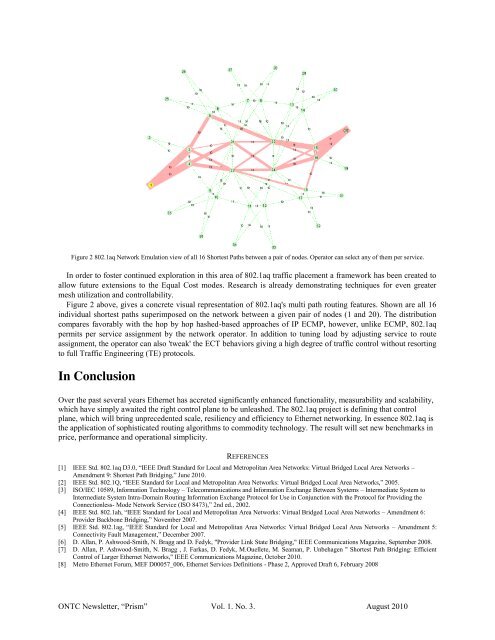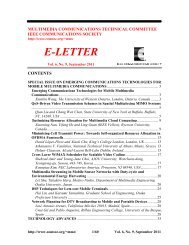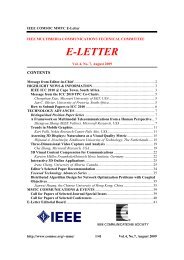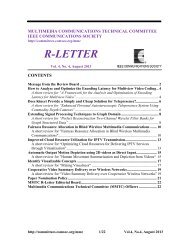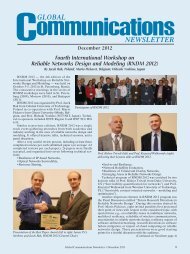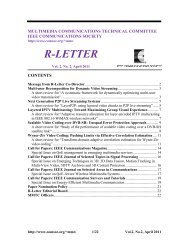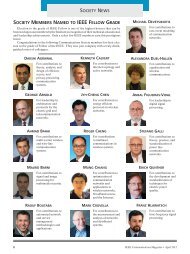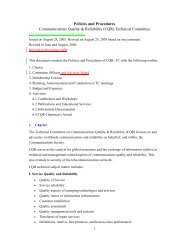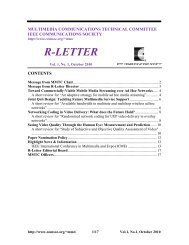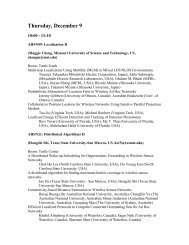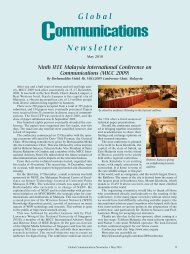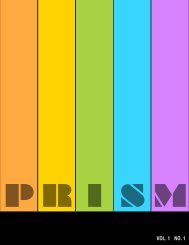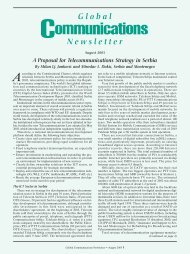PRISM - vol. 1, no. 3 - IEEE Communications Society
PRISM - vol. 1, no. 3 - IEEE Communications Society
PRISM - vol. 1, no. 3 - IEEE Communications Society
Create successful ePaper yourself
Turn your PDF publications into a flip-book with our unique Google optimized e-Paper software.
Figure 2 802.1aq Network Emulation view of all 16 Shortest Paths between a pair of <strong>no</strong>des. Operator can select any of them per service.<br />
In order to foster continued exploration in this area of 802.1aq traffic placement a framework has been created to<br />
allow future extensions to the Equal Cost modes. Research is already demonstrating techniques for even greater<br />
mesh utilization and controllability.<br />
Figure 2 above, gives a concrete visual representation of 802.1aq's multi path routing features. Shown are all 16<br />
individual shortest paths superimposed on the network between a given pair of <strong>no</strong>des (1 and 20). The distribution<br />
compares favorably with the hop by hop hashed-based approaches of IP ECMP, however, unlike ECMP, 802.1aq<br />
permits per service assignment by the network operator. In addition to tuning load by adjusting service to route<br />
assignment, the operator can also 'tweak' the ECT behaviors giving a high degree of traffic control without resorting<br />
to full Traffic Engineering (TE) protocols.<br />
In Conclusion<br />
Over the past several years Ethernet has accreted significantly enhanced functionality, measurability and scalability,<br />
which have simply awaited the right control plane to be unleashed. The 802.1aq project is defining that control<br />
plane, which will bring unprecedented scale, resiliency and efficiency to Ethernet networking. In essence 802.1aq is<br />
the application of sophisticated routing algorithms to commodity tech<strong>no</strong>logy. The result will set new benchmarks in<br />
price, performance and operational simplicity.<br />
REFERENCES<br />
[1] <strong>IEEE</strong> Std. 802.1aq D3.0, “<strong>IEEE</strong> Draft Standard for Local and Metropolitan Area Networks: Virtual Bridged Local Area Networks –<br />
Amendment 9: Shortest Path Bridging,” June 2010.<br />
[2] <strong>IEEE</strong> Std. 802.1Q, “<strong>IEEE</strong> Standard for Local and Metropolitan Area Networks: Virtual Bridged Local Area Networks,” 2005.<br />
[3] ISO/IEC 10589, Information Tech<strong>no</strong>logy – Telecommunications and Information Exchange Between Systems – Intermediate System to<br />
Intermediate System Intra-Domain Routing Information Exchange Protocol for Use in Conjunction with the Protocol for Providing the<br />
Connectionless- Mode Network Service (ISO 8473),” 2nd ed., 2002.<br />
[4] <strong>IEEE</strong> Std. 802.1ah, “<strong>IEEE</strong> Standard for Local and Metropolitan Area Networks: Virtual Bridged Local Area Networks – Amendment 6:<br />
Provider Backbone Bridging,” November 2007.<br />
[5] <strong>IEEE</strong> Std. 802.1ag, “<strong>IEEE</strong> Standard for Local and Metropolitan Area Networks: Virtual Bridged Local Area Networks – Amendment 5:<br />
Connectivity Fault Management,” December 2007.<br />
[6] D. Allan, P. Ashwood-Smith, N. Bragg and D. Fedyk, "Provider Link State Bridging," <strong>IEEE</strong> <strong>Communications</strong> Magazine, September 2008.<br />
[7] D. Allan, P. Ashwood-Smith, N. Bragg , J. Farkas, D. Fedyk, M.Ouellete, M. Seaman, P. Unbehagen " Shortest Path Bridging: Efficient<br />
Control of Larger Ethernet Networks," <strong>IEEE</strong> <strong>Communications</strong> Magazine, October 2010.<br />
[8] Metro Ethernet Forum, MEF D00057_006, Ethernet Services Definitions - Phase 2, Approved Draft 6, February 2008<br />
ONTC Newsletter, “Prism” Vol. 1. No. 3. August 2010


